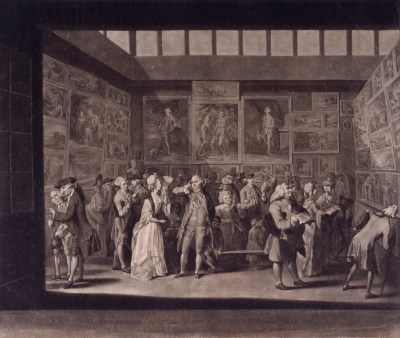
James Jefferys and James Barry RA, The Body of Lucretia Exposed to the Romans, 1770s?.
Pen and brown ink with grey wash on thin laid paper. 595 mm x 910 mm. © Photo: Royal Academy of Arts, London.
This image is not available to download. To licence this image for commercial purposes, contact our Picture Library at picturelibrary@royalacademy.org.uk
The Body of Lucretia Exposed to the Romans, 1770s?
Attributed to James Jefferys (1751 - 1784) and Formerly attributed to James Barry RA (1741 - 1806)
RA Collection: Art
A pen and ink composition depicting an agitated crowd listening to a central figure in a setting with Classical architecture.
This drawing was, like the others in the same group, previously attributed to James Barry. It was published as such in an article about the Royal Academy's collection of drawings in 1969 and exhibited in the 'Age of Neo-Classicism' exhibition at the RA in 1972 as a 'Composition for an unknown subject' . During the 1970s this drawing and the rest of the group were convincingly re-attributed to James Jeffreys. In a subsequent article, Nancy Pressly re-identified the subject as 'The Body of Lucretia Exposed to the Romans'. She argued that the scene depicts Junius Brutus displaying the dead body of Lucretia - who committed suicide after being raped by Sextus Tarquinus - and exhorting the people of Rome to take up arms against the Tarquin family. Pressly pointed out that the impassioned orator points behind him to a limp and apparently lifeless female body being carried by another figure and that the crowd, many with their arms raised, appear to be swearing an oath. This subject was also depicted by artists whom Jefferys knew or emulated including James Durno and Gavin Hamilton (1772 and 1768 respectively). While Pressly acknowledged that it is possible that the scene could also be identified as depicting Mark Anthony's oration over the body of Caesar, this seems less likely as the central figure does not hold the murdered emperor's torn robe and the dead body appears to be female.
There are two studies in the British Museum, one relating to the right sides of this composition and the other to the left (1870-5-14-203 and 1870-5-14-203).
These six unsigned drawings of historical subjects appear to be by the same hand and were for many years attributed to the Irish painter James Barry. However, during the 1970s, it was noted that several drawings in the group are inscribed "Rome" and "Florence" and dated "1777" and "1778". This put the attribution to Barry under question as he left Italy in 1770. Around the same time, a group of very similar drawings in Maidstone Museum were found to be the work of a little-known artist, James Jefferys (1751-1784). Comparing these examples with the RA group and two further groups of related drawings in the British Museum and the V&A - also previously attributed to Barry - it was generally agreed that all the drawings were probably by Jefferys.
Born in Maidstone, Kent, in 1751, Jefferys was educated locally and received artistic training from his father William Jefferys (?1723 - 1805), a coach painter who had studied with Francis Hayman. Jefferys' work had been largely forgotten until the drawings at Maidstone were discovered. During his lifetime, however, he was considered a prodigy and won numerous prizes for his work. He died from a fever in London in 1784 before he had fulfilled his early promise and most of his output consisted of drawings.
In November 1772 Jefferys joined the Royal Academy Schools and it is possible that he was also a pupil of John Hamilton Mortimer, whose style he initially imitated. He won several prizes from the Society of Arts and the Royal Academy, and on the recommendation of Sir Joshua Reynolds he was also awarded a travelling scholarship from the Society of Dilettanti, with which he set out for Italy, reaching Rome on 7th October 1775. Jefferys exhibited five drawings and four other works at the Royal Society of Arts between 1771-1774. Jefferys only exhibited twice at the RA, showing two works in 1775 and an oil painting in 1783. All except two of his exhibited works were of historical or allegorical subjects.
Two of the RA's Jeffery drawings bear inscriptions relating to Rome and Florence and are dated 1777 and 1778. This accords with Edward Edwards's statement that Jefferys 'staid in Italy about four years'. Alexander Day wrote to Ozias Humphrey describing Jefferys in Rome, stating 'I have seen a drawing...he has made since his arrival which I think has infinite merit'. In his DNB entry, Martin Myrone writes that Jeffery's contemporaries in Rome were impressed by his drawings, which, in 'their emphatically linear style and heroic conception show a continuing debt to the example of [John Hamilton] Mortimer and the draughtsmanship of James Barry (1741–1806)'.
References:
Timothy Clifford and Susan Legouix, 'James Jefferys, Historical Draughtsman (1751- 1754)', The Burlington Magazine, Vol 118, March 1976, pp. 148-157
Timothy Clifford and Susan Legouix, The Rediscovery of an Artist - The Drawings of James Jefferys (1751-1784), exh. cat., V&A Museum, 1976
Martin Myrone, ‘Jefferys, James (1751–1784)’, Oxford Dictionary of National Biography, Oxford University Press, 2004
Object details
595 mm x 910 mm
Start exploring the RA Collection
- Explore art works, paint-smeared palettes, scribbled letters and more...
- Artists and architects have run the RA for 250 years.
Our Collection is a record of them.



